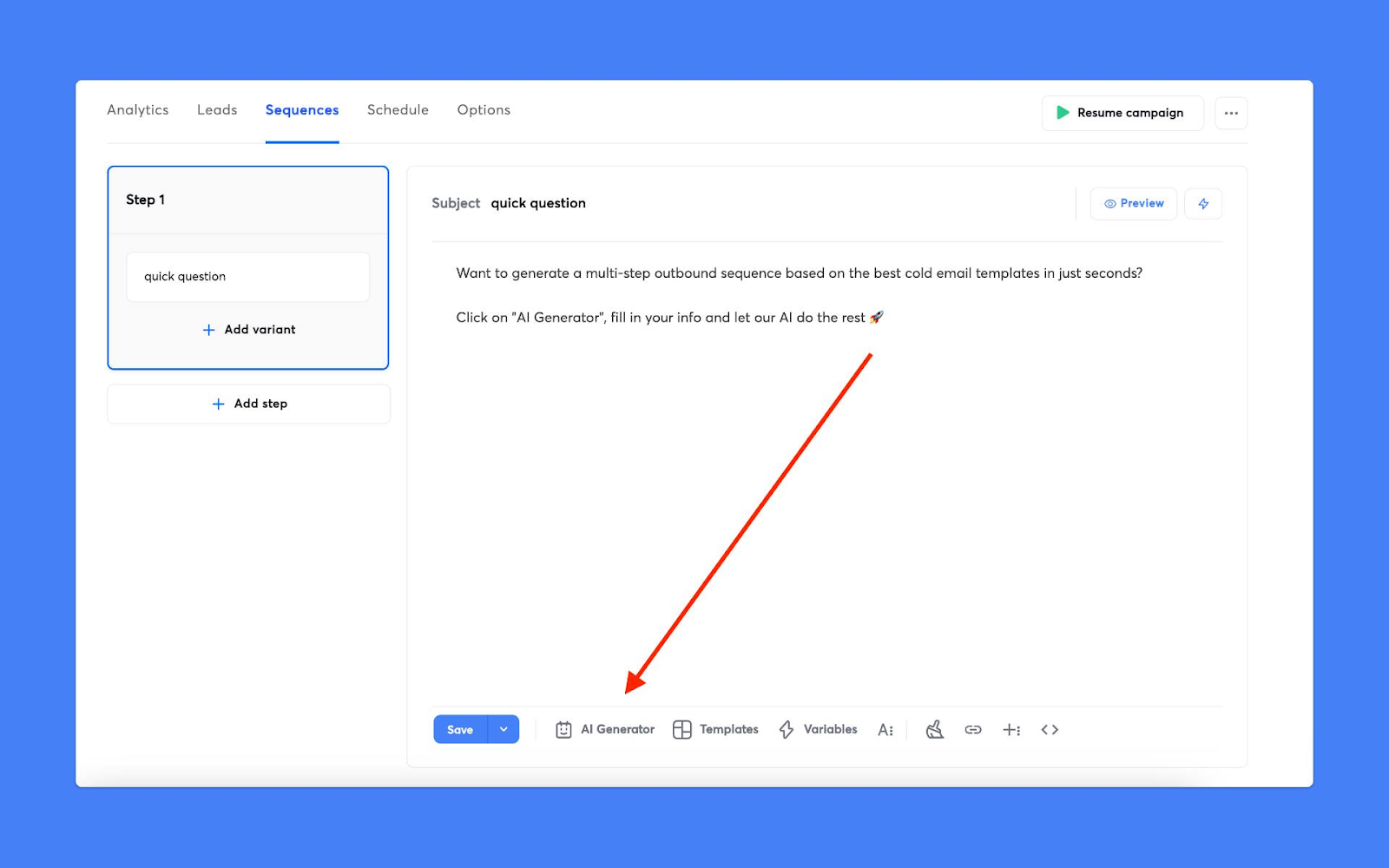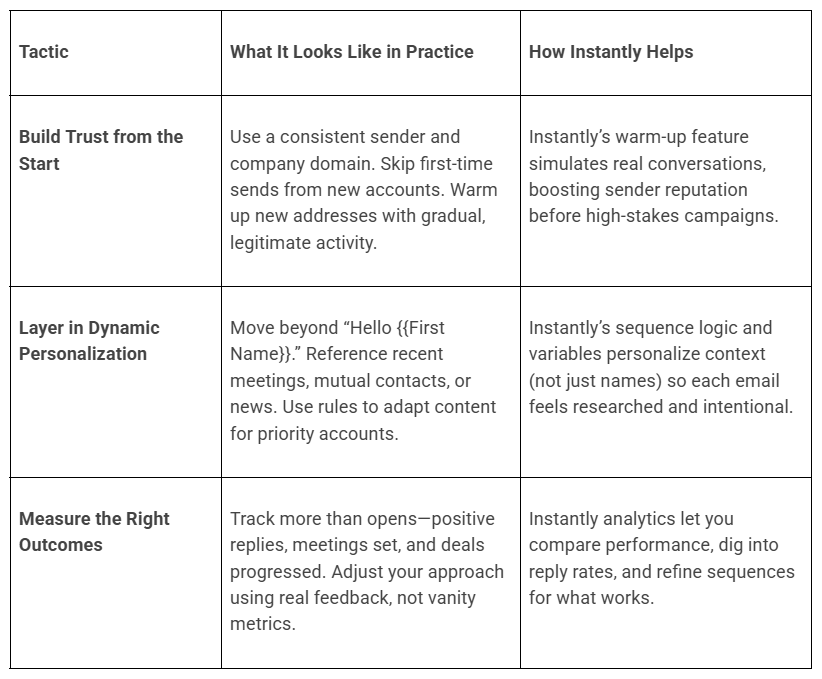It’s easy to dismiss formal emails as old school or stuffy. But in a world where inboxes are crowded with generic outreach and rushed notes, professionalism stands out. The right structure, tone, and attention to detail set you apart. In B2B, it’s how you prove you’re worth a response.
Here’s the part most “email format” guides skip: Formal doesn’t mean robotic. You’re not aiming for a template that strips out all personality. You want clarity, confidence, and respect for the reader’s time—plus a little of your own voice in every line. That’s what builds real connection, whether you’re cold-emailing a potential partner or confirming next steps with a client.
The best formal emails are unremarkable in all the right ways—clear intent, steady tone, not a single misplaced line. They don’t draw attention to themselves, but to the work at hand and the relationship you’re building.
This guide will show you what a formal email looks like in 2025: how to nail the basics, where most people slip up, and how to keep your outreach sharp (even when you’re sending hundreds at a time). You’ll see how Instantly can help you scale professionalism, without losing the human touch.
What Is a Formal Email?
A formal email is a direct message with a single focus: professional affairs. You use it when you need to connect, inform, or ask for action, without any distractions. Each part of the email serves a purpose, from the subject line to the sign-off.
You reach for a formal email when you’re making a first impression, sharing sensitive details, confirming agreements, following up after meetings, or reaching out to someone you haven’t met. It’s often the right approach for cold outreach, partnership pitches, contract negotiations, and project updates—anytime clarity and credibility matter.
What sets a formal email apart is the standard it sets. The tone is respectful and concise. The content gets to the point. There’s no wasted language or filler—just information that moves the conversation forward.
Being formal doesn’t mean being stiff. Your writing should show you understand the context and value the recipient’s time. It’s not about sounding impressive—it’s about being clear, careful, and easy to answer.
When the stakes are high or the details can’t be missed, a formal email is your strongest tool. The rest is learning how to use it well.
Anatomy of a Modern Formal Email
A well-written formal email looks simple. That’s the hard part. Each section (subject line, greeting, opening, body, closing) has a specific job. Get each part right, and you make it easy for the reader to respond or move things forward.
Subject Line
You get one line to make your case. Be direct, not dramatic. The ideal subject line is clear, specific, and practical. You want the recipient to know exactly why you’re reaching out before they open the email. Skip all-caps, wordy intros, or phrases like “Quick question”—these usually end up ignored or in spam.
Examples:
- “Time off request: March 10, 2025”
- “Partnership with Acme Corp?”
- “Proposal: Quarterly review meeting”
These give context, respect the reader’s time, and avoid sounding like marketing blasts.
Greeting & Address
Lead with “Hello {{Name}},” or “Hi {{Name}},” for most professional settings. If you have no prior relationship or want to signal extra formality, use “Dear {{Title}} {{Last Name}}.” When the recipient’s name is unknown, address their role: “Hello Marketing Team” is better than “To whom it may concern.”
Examples:
- “Hello Sam,”
- “Dear Dr. Pattison,”
- “Hi Finance Team,”
Personalization matters—a named email greeting lifts open rates and shows attention to detail.
Opening Paragraph: Why Context Wins
The first line should state your intent. Avoid empty pleasantries and get to the reason for your email right away. Reference something specific—a recent event, a shared contact, or a clear business objective. This shows you understand their world and aren’t sending mass mail.
Weak: “I hope this email finds you well. I’m reaching out about a possible collaboration.”
Stronger: “I saw your team’s launch of the new analytics platform last week. I’m reaching out to discuss a partnership that could support your next phase.”
Make the relevance obvious. Recipients shouldn’t have to guess why you’ve appeared in their inbox.
Body: Clarity, Structure, & Action
Break your message into small, focused paragraphs. Each paragraph should cover one idea or task. Use bullets or numbered lists for multiple points. Sentences should be tight—cut anything that doesn’t help move the conversation forward.
Example:
I’d like to propose a call to discuss:
- How our platforms could integrate for client reporting
- A potential schedule for pilot testing
- Next steps if you’re interested
Match the tone to the context: professional, confident, but easy to read. Avoid jargon and long-winded explanations.
Closing & Next Steps
End with a clear, respectful sign-off: “Best regards,” “Sincerely,” or “Thank you.” Make your call to action easy to spot. Say exactly what you’d like the recipient to do next—whether it’s scheduling a meeting, reviewing a document, or replying with a decision.
Example:
I’m available for a call next week if you’re interested. Let me know what your schedule looks like.
Then add a complete signature: your full name, job title, company, and contact info. You want to make it easy for the reader to follow up.
Proofreading & Deliverability
Typos, broken formatting, and missing details can kill your credibility. Before you send, reread the message once for sense, and a second time for polish. Check links, attachments, and names.
Deliverability matters too. Avoid spammy language, unnecessary attachments, and too many links. If you’re sending at scale, Instantly’s deliverability tools and warm-up features help your emails land where you want them—in the primary inbox, not promotions or spam.

Templates: Plug-and-Play Formal Emails for Every Scenario
Even if you know the fundamentals of formal email, starting from scratch every time wastes energy and introduces mistakes. Templates solve for that. They give you a proven structure, but leave enough room to tailor your message. The best ones are easy to personalize, hard to misuse, and effective for all the scenarios where clarity matters most.
Below are four templates covering the situations professionals face most often: cold outreach, partnership requests, formal follow-ups, and meeting requests or confirmations. Each template includes customizable fields and a note on how to adapt them using Instantly’s sequence builder or personalization tags.
Cold Outreach
Subject: {{Specific reason}} for {{Recipient’s Company}}
Hello {{First Name}},
I’m {{Your Name}}, and I came across your work on {{context/recent project}}. I wanted to reach out because {{state-specific reason or mutual interest}}.
{{One or two sentences explaining the benefit or value you can offer.}}
If you’re open to a quick call, I’d love to learn more about your current {{challenge or goal}} and explore whether we’re a fit.
Best regards,
{{Your Name}}
{{Title}},
{{Company}}
{{Contact info}}
Partnership Request
Subject: Exploring a partnership between {{Your Company}} and {{Their Company}}
Dear {{Title}} {{Last Name}},
Your work on {{recent initiative or product}} stands out in our space. At {{Your Company}}, we’re looking to connect with teams focused on {{shared goal or challenge}}.
Would you be interested in a short conversation to discuss how our companies might collaborate or support each other’s efforts?
Looking forward to your thoughts,
{{Your Name}}
{{Title}},
{{Company}}
{{Contact info}}
Formal Follow-Up
Subject: Follow-up: {{Original Topic/Meeting}}
Hi {{First Name}},
I wanted to follow up on my earlier email regarding {{topic/project}}. If you’ve had a chance to review, I’d welcome your feedback or next steps.
If it’s easier, I’m available for a brief call this week or next.
Thank you,
{{Your Name}}
{{Title}},
{{Company}}
{{Contact info}}
Meeting Request/Confirmation
Subject: Confirming meeting: {{Date/Topic}}
Hello {{First Name}},
I’m writing to confirm our meeting on {{date}} at {{time}}, regarding {{topic}}. Please let me know if anything has changed or if you’d like to adjust the agenda.
Looking forward to our conversation.
Best regards,
{{Your Name}}
{{Title}},
{{Company}}
{{Contact info}}
Each template here is easy to edit and quick to personalize at scale. Instantly’s AI sequence builder and dynamic variables let you plug these frameworks in, add recipient-specific details, and keep every message sharp, even when you’re sending to dozens or hundreds of contacts at once.

Scaling Formal Email: When Volume Meets Professionalism
Sending a single polished email is one thing; sending fifty that all sound personal is another. Volume brings risk. Templates get blunt, details slip, and tone can drift from professional to impersonal or downright unprofessional. When you’re running outreach across a list, the challenge is keeping every message as sharp and intentional as the first.
That’s where process and tools matter. The basics never change: subject line, structure, clarity, respect for the recipient’s time. But automation is only as good as your setup. Personalization is what makes the difference—using variables and logic so your contact’s name, company, and even context-specific references show up in the right places.
If you’re sending campaigns at scale, Instantly steps in here. With dynamic variables and smart sequence logic, it’s possible to tailor each message far beyond just a “first name” swap. Internal notes, previous interactions, role-specific offers—these can all automatically adapt, so no one gets a message that feels like a copy-paste.
Deliverability counts even more at volume. A minor slip—a broken link, a misspelled name, a formatted list gone wrong—gets multiplied across hundreds of inboxes. Automated checks, internal reviews, and Instantly’s warm-up and deliverability dashboards keep your emails consistent, error-free, and out of the spam folder.
Scaling formal email is about putting systems behind your standards. The volume goes up, but your credibility stays high, because quality isn’t something you ever want to automate away.
Advanced Tactics for High-Stakes Outreach
Some emails call for more than careful formatting—they demand extra precision. When you’re reaching out to senior decision-makers, potential partners, or negotiating big deals, little details become big differentiators.
Here’s how to raise your game in high-stakes outreach:

High-stakes email is about showing you notice the details—and proving it with every line you send.
Key Takeaways
Strong formal emails don’t rely on tricks, jargon, or clever phrasing. They succeed by making it easy for people to read, understand, and respond. Whether you’re reaching out cold or running a campaign at scale, structure and clear intent always win.
Keep these points in mind:
- Use a direct subject line and a clear, respectful greeting.
- State your purpose right away—don’t bury the lead.
- Personalize wherever possible, especially at scale.
- Double-check your message for errors before you hit send.
- Use automation for consistency, but never at the cost of credibility.
When you’re ready to make every message count, Instantly.ai can help you scale your outreach without losing your standards. Start your free trial to see how Instantly helps teams write emails that get real results.





